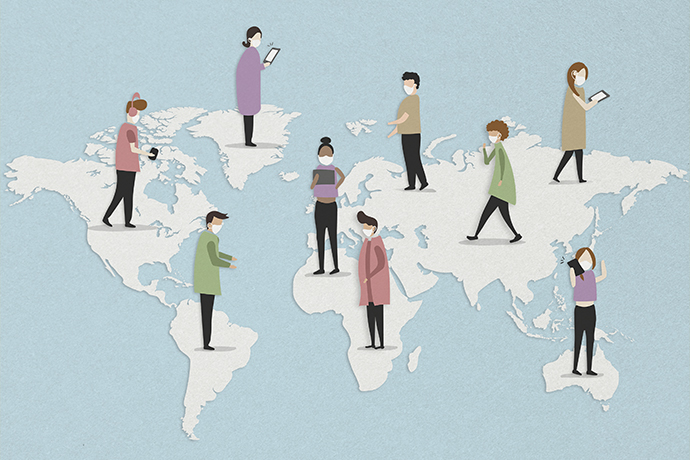 SPEAKERS
SPEAKERS
Cultural awareness is vital in diverse workplaces, fostering understanding and collaboration among employees from different backgrounds.

Picture this;
You walk into an office, and the receptionist welcomes you with an Amharic accent. She calls the HR office and instructs you to have a seat as you wait for the HR manager. Shortly, the manager walks in. He is a Caucasian. After him, you find out the finance manager is Indian; the office manager is Latino.
When you look around, you notice employees from different cultures. The office space is peaceful, everyone seems to collaborate, and the work flows seamlessly.
This is today’s reality.
Modern companies have diverse teams of employees from different backgrounds. This is because of the rise of Diversity and Inclusion (D&I) initiatives. D&I initiatives are increasingly becoming mandatory, and the younger generation deems them non-negotiable.
The hub of such a diverse work setting is cultural awareness.
But hold on a minute;
What is cultural awareness, and how does it apply to modern offices?
This piece examines this concept in depth, particularly highlighting the specific diversity and inclusion strategies that enhance it.
Ready to learn?
Here are the facts.
Cultural awareness meaning is being aware of the similarities and differences between cultures. This sensitivity influences how you act and communicate with your colleagues. It’s being open-minded and respectful of everyone you interact with.

Cultural awareness is the oil that keeps the engine running in a diverse workplace. It isn’t limited to physical offices, but also companies operating fully or partially online.
Today’s workplaces require this sensitivity because it improves official communication. This awareness helps you understand and accept that different cultures may have differing communication styles. Some cultures adopt direct communication, while others prefer indirect communication, where you follow a hierarchy.
Cultural awareness is also important because it boosts collaboration. It helps create the amicable rapport and respect necessary for operational collaboration.
Third, cultural awareness elevates creativity and innovation within the workforce. This is because the collective embraces each team member’s perspectives. This benefit is especially helpful during brainstorming sessions.
Yes, there are!
These strategies help employees strengthen their bond for better communication, collaboration, and creativity. The top diversity and inclusion strategies that also work to enhance cultural awareness in the workplace are:
Open communication allows every employee to speak their mind and contribute equally. D&I strategies that enforce this include using Employee Resource Groups (ERGs). Mentorship programs also promote open communication within the workplace.
ERGs are employee-led teams based on shared backgrounds. For instance, the Asian Heritage Network (AHN). This group connects Asians in a company where they contribute to better cultural awareness. Such groups educate the rest on cultural sensitivities, allowing the sharing of information.
Mentorship programs are cultural awareness initiatives that pair or group employees from varying backgrounds. These collaborations are excellent platforms to promote cultural exchange. In this arrangement, the mentors and mentees exchange ideas, share views, learning from each other.
These programs break cultural and historical boundaries, allowing employees to communicate openly.
Inclusivity also enhances cultural awareness in the workplace. These practices include physical and language accessibility and flexible work arrangements.
Language accessibility encompasses the use of translated media and linguistic training. Offices with visual aids and interpretation features, such as translation tools fulfill this purpose. These seemingly minor additions ensure everyone feels like an equal part of the team. They also maintain high attendance and participation during all business interactions.
A business that welcomes flexibility accommodates everyone. Flexible work arrangements also promote work-life balance, keeping everyone healthy and productive. These may also include issuing leaves like parental or mental health breaks.
Once your organization hacks open communication, a culture of giving feedback follows.
This entails setting up anonymous feedback channels that allow employees to air their grievances without judgement. A suggestion box mounted somewhere in a physical office is a type of feedback channel. The modern world allows us to use digitally available solutions that remote employees can use. Anonymous surveys and feedback apps are perfect examples.
You can write down and share questions on cultural awareness or bring other matters to light.
These insights help the managerial teams identify areas needing improvement and intervention.
Feedback in the workplace is incomplete without follow-up, so much so that regular follow-ups are mandatory. Companies should follow up on any issue addressed to ensure that the employee is doing well and changes have been enforced.
Another fundamental D&I strategy that enhances cultural awareness at work is training and development.
These may include workshops that equip colleagues with the knowledge to appreciate all cultures fully. These workshops address unconscious bias, inclusive language, and cross-cultural communication topics.
Training and education may also encompass cultural competency programs. These trainings dig deeper into specific cultures, deconstructing their various aspects. These in-depth programs run lessons on varying cultural values, norms, and communication styles.
Now, here is the fun part: celebrating diversity!
A diverse workforce learns to appreciate each other better once they experience their joys and sorrows. One way is by participating in holidays, events, and festivals of different cultures.
Another fun way is to participate in cultural food days or potlocks. These allow you and your colleagues to share delicacies and learn how to make them. These interactions steer you away from serious business topics, and they further break walls and barriers that may exist within the workplace.

Cultural awareness isn’t a one-day activity but an ongoing initiative. This initiative aims to ensure colleagues keep learning about each other. It regularly checks in to promote workplace communication, collaboration, productivity, innovation, and creativity.
Open communication and inclusive practices are the diversity and inclusion strategies that enhance cultural awareness. A culture of feedback, training, education, and appreciation of diversity solidifies cultural awareness.
When you and your colleagues keep learning and experiencing new things, you become culturally aware. This solidifies the foundation for creating a team that works cohesively towards a common goal: success.
